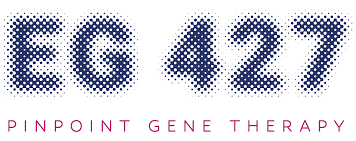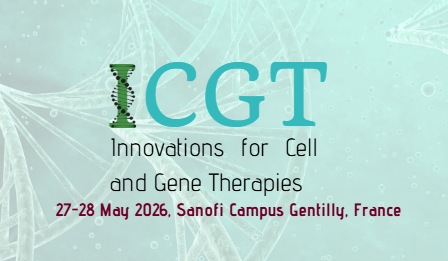With “The Experts Corner,” MabDesign offers a deep dive into the heart of innovation in biotherapies. Through exclusive interviews with industry experts, discover their market vision, their analyses of current challenges, and their perspectives on the latest advances. These inspiring conversations will help you better understand the present and future of biomanufacturing and biopharmaceuticals.

Gene Therapies
Samuel Salot
Director Of Operations, EG427
Technologies are becoming increasingly sophisticated, but also more targeted and adaptable. It’s reminiscent of antibodies in the 1990s: we are entering a phase of accelerated maturation.

EG 427 is a French biotech founded in 2019, with a DNA therapy approach that we define as targeted. Unlike other systemic approaches, our technology relies on a non-replicative herpes vector, allowing extremely precise targeting of specific neurons. Once inside, it can express transgenes in a stable, selective, and long-lasting way — opening the door to durable therapeutic effects.
Our first developments focus on indications linked to the peripheral nervous system, but the platform has a much broader potential, notably thanks to its ability to integrate large transgenes and to leverage the natural latency of HSV. This allows fine regulation of therapeutic transgene expression, including for complex applications.
Today, we have an active clinical program: in June 2024, the FDA authorized us to launch a trial in neurogenic bladder, a common condition with significant unmet patient needs. This demonstrates both the medical relevance and the maturity of our technology.
- You are currently COO of EG 427. Could you tell us about your background before joining the company, and explain your current role?
I started my career at Innate Pharma, where I was trained in the fundamentals of biopharmaceutical development. My very first project was in cell therapy, which quickly led me to explore gene transfer and immunotherapy. I then co-founded a service company specializing in immuno-monitoring, a spin-off from Innate, before moving into strategic consulting for French biotechs. There, I supported projects on CAR-T, monoclonal antibodies and derivatives, as well as therapeutic vaccines, often linked to development or corporate structuring challenges.
It was during this period that I met Philippe Chambon, CEO of EG 427. He had just returned from the United States with the ambition to develop this innovative viral technology. He offered me the opportunity to help him build the company from scratch. Together, we set up the infrastructure, recruited the first teams, laid the foundations of the development plan, and most importantly, worked on bioproduction processes.
My role has evolved with the company’s growth, and I am now heavily involved in strategic, industrial, and regulatory aspects, particularly around our lead asset, EG110A.
- You mentioned that you started working in gene therapy very early. How have you seen the field evolve, particularly in terms of major technological advances?
“The arrival of CAR-T, driven by figures such as Carl June and Michel Sadelain, marked a real paradigm shift.”
When I started, cell therapy was still experimental. Expectations were high, but so were the limitations: lack of standardization, high costs, limited reproducibility. The arrival of CAR-T, driven by figures such as Carl June and Michel Sadelain, marked a real paradigm shift. The launch of Kymriah was a strong signal for the industry.
At the same time, tangible results began to emerge in “pure” gene therapy, with vectors such as AAV, particularly in rare diseases like Duchenne muscular dystrophy. But the field remains cyclical. Before COVID, annual investments reached around $25 billion, only to face a steep drop after the crisis. That said, innovation never stopped. The recent acquisition of Capstan Therapeutics by AbbVie — to develop in vivo CAR-T using non-viral vectors — illustrates how simpler, more industrializable models are emerging.
Technologies are becoming increasingly sophisticated, but also more targeted and adaptable. It’s reminiscent of antibodies in the 1990s: we are entering a phase of accelerated maturation.
- Monoclonal antibodies are now a mature field, unlike newer approaches such as gene or cell therapies. Do you see fundamental differences in terms of developability, business model, or industrial trajectory?
“Our processes are close to those of vaccine production: proven, easy to scale industrially.”
Absolutely. Autologous therapies make sense scientifically, but they raise major issues in terms of logistics, standardization, and reimbursement. Their industrialization remains challenging. Allogeneic approaches, though promising, still face biological hurdles — compatibility, rejection, expansion.
In contrast, vectorized gene therapies, such as AAV, have the potential to reach broader populations — provided that manufacturing costs are reduced and processes optimized.
This is where our non-replicative HSV approach is highly relevant. Our processes are close to those of vaccine production: proven, easy to scale industrially. The vector quantities required per dose are low, which means production costs are significantly lower than for AAV. This model enables us to envision broader applications, particularly for high-prevalence chronic diseases.
- You have now entered the clinical stage with your product. What do you see as the main translational challenges in moving from preclinical to Phase I?
“Preclinical is the stage where you lay the foundations — and those foundations must be solid.”
A key point was integrating regulatory considerations from the start. As early as 2021, we structured our development plan with FDA expectations in mind, and engaged in dialogue with them very early on. This allowed us to perform useful gap analyses and adjust our priorities accordingly.
Scientifically, the challenge is to turn an innovative idea into robust preclinical data. Often, the tools don’t yet exist: you need to design or adapt specific assays, avoid generating unusable data, and stay focused on what matters — efficacy and safety.
This work requires constant agility, because new obstacles arise every week. Preclinical is the stage where you lay the foundations — and those foundations must be solid.
You are working on an innovative therapy. How do you manage relationships with regulatory agencies?
“Demonstrate efficacy, ensure safety, and understand the mechanism of action.”
We chose to engage with the authorities very early, even at a stage when some elements were not yet fully established. In the United States, interactions with the FDA were particularly constructive. They helped us refine our hypotheses and build a clear plan.
In parallel, we built a network of top-level experts — in CMC, analytics, pharmacology. These are highly experienced people who work with us continuously, not just on an ad-hoc basis.
This approach allowed us to make every development decision with regulatory requirements in mind, which I believe is essential for innovative projects. We have always sought to focus on what matters: demonstrate efficacy, ensure safety, and understand the mechanism of action.
- In your view, what are the key elements of a strong ecosystem to develop an innovative gene therapy?
“The success of a program is not just about technology.”
Both internal collaborations, often underestimated, and external partnerships.
Internally, strong alignment between leadership, investors, and operational teams is critical to ensure project success. It requires transparency, listening, and shared objectives. Internal tensions can hold back even the most innovative projects.
Externally, the human factor is crucial. Working with competent providers is important — but working with engaged ones is essential. A good example is our collaboration with our Italian CDMO. We were very present on site because we wanted to understand the issues and move forward together. Shared responsibility must be assumed, even when difficulties arise.
The success of a program is not just about technology. It’s also about human relationships, trust, and mutual commitment.
- You are based in Cochin, with a presence in the United States. In your opinion, what role does the local ecosystem play in developing your gene therapy?
“We have always had a global vision: we seek expertise wherever it is, whether in Paris, the United States, or elsewhere in Europe.”
We have always had a global vision: we seek expertise wherever it is, whether in Paris, the United States, or elsewhere in Europe. The local ecosystem is important when it brings value, but we don’t limit ourselves to it.
We faced a specific regulatory constraint in France — the MOT (Microorganisms and Toxins) regulation — which heavily restricts certain manipulations involving our transgene, even though it is only a non-toxic fragment of botulinum toxins. These unique French constraints forced us to outsource certain operations abroad, including production in Italy and Germany.
This was not a matter of convenience, but a regulatory necessity. It also highlights the difficulty of developing some innovations within a rigid local framework. Hence the importance of remaining pragmatic and agile in choosing partners and sites.
- How do you view the evolution of the competitive landscape in gene therapy?
“AbbVie’s acquisition of Capstan, with its in vivo CAR-T approach, is a strong signal…”
I don’t see the field as one of direct competition, but rather as a sector under construction, with room for multiple models. AbbVie’s acquisition of Capstan, with its in vivo CAR-T approach, is a strong signal: the shift from costly platforms to more industrializable solutions is underway. This opens the way for the democratization of gene therapy, with potentially curative treatments compatible with large-scale production. At EG 427, this is precisely our ambition: to make DNA therapy accessible, standardized, and economically viable for healthcare systems.
Our technology is built on solid foundations: HSV is well known, minimally immunogenic, and re-administrable. Our ambition is to make these innovations available to the largest number of patients, particularly for high-prevalence chronic diseases.
Samuel Salot, EG427, interviewed by the MabDesign team - July 2025
Since this interview, EG427 has issued two press releases announcing clinical results and the receipt of a Fast Track Designation from the U.S. Food and Drug Administration. Their press releases are available here:
DO YOU WANT TO KNOW MORE?

Don’t miss the Innovations for Cell and Gene Therapies “ICGT”, organized by MabDesign, which will take place on May 27 and 28, 2025 in Sanofi Campus Gentilly, France.
More Information Here or contact us for more information !
MabDesign has acquired and cultivated expertise in all areas associated with biomedicines and biomanufacturing. Our team is at your disposal to support you in all your projects related to the biotherapies sector, and in particular cell-based therapies. Feel free to explore our range of services, training courses and events if you’d like to find out more!

